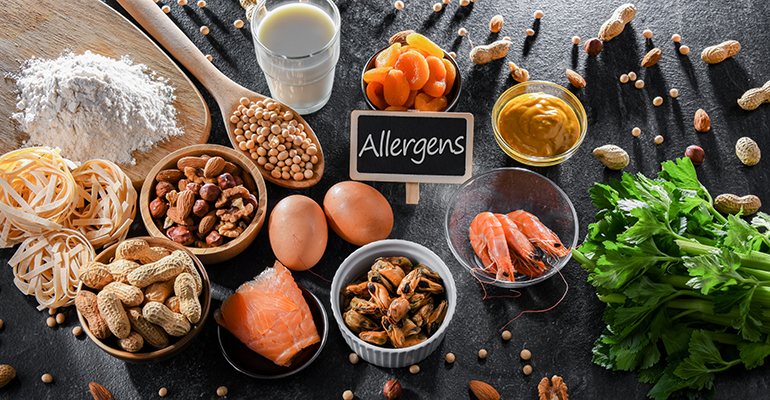News
EU calls to harmonise allergen labelling increase
1 Jan 2025Allergy awareness efforts focus on implementing a European reference laboratory and collaboration to standardise labels and support allergen identification.
Allergen labelling varies across European countries. Unifying standards and fostering collaboration throughout Europe could support the harmonisation of allergen labelling.

Wageningen University and Research, based in the Netherlands, has said that scientists and allergen-focused advocates are calling for a European reference laboratory to harmonise food and beverage labels. A European reference laboratory could manage the comprehensive research needed to achieve this and systematically monitor allergen handling on a region-wide scale.
“The growing complexity of the global food supply chain and increased public awareness of food allergies are key drivers for harmonisation in allergen labelling across the UK and the European Union (EU),” Caroline Benjamin, director of Food Allergy Aware, told Ingredients Network. “Inconsistent labelling practices can cause confusion for consumers, especially for those managing severe allergies,” Benjamin explained.
Single-nation led allergen developments
In 2024, the Netherlands adopted national legislation to regulate precautionary labels on foods and allergen cross-contamination. Following the directive’s introduction, by 2026, producers may only use labels like these if they have considered the risks of consumption when allergies are present.
Yet, this development only applies to the Netherlands and the 400,000 people with food allergies. As such, Nathalie Smits of Wageningen Food Safety Research, and colleagues from seven more European countries are calling on the EU to centralise allergen monitoring. “A consumer crossing the border cannot trust that labels mean the same thing they do in the Netherlands,” said Smits, adding “That is limiting, or even dangerous.”
The introduction of Natasha’s Law in the UK brought clarity for prepacked for direct sale (PPDS) foods, for example. However, currently, this regulation does not exist in the EU and can confuse UK consumers with food hypersensitivities (FHS) when travelling to EU countries. The UK Food Standards Agency (FSA) states that food hypersensitivities (FHS) refer to allergies, intolerances, and coeliac disease.
Making safe, informed food selections
Allergen incidents highlight the importance of best practice full labelling. “A harmonised approach will ensure transparency and build trust from the FHS consumer, which in turn will support the FHS consumer in making safe choices,” said Benjamin.
Furthermore, food businesses benefit from clearer regulations, reducing non-compliance risk and facilitating smoother cross-border trade. However, to achieve true harmonisation, allergen standards, and rules need to go beyond best practice. “The harmonisation needs to be regulated and not just best practice,” Benjamin added.
A lack of standardisation remains
Without harmonised allergen labelling in the EU, a lack of standardisation creates various risks for consumers and the wider food sector. As demonstrated by the concerns and challenges for FHS consumers, the non-harmonised allergen labelling standards create consumer safety risks. “Inconsistent allergen labelling can result in miscommunication, leading to accidental exposure and potentially life-threatening allergic reactions,” Benjamin explained.
For instance, varying definitions or interpretations of PPDS foods across countries might lead to gaps in allergen disclosure. PPDS foods refer to items packaged and sold at the same venue, such as at food service and hospitality locations.
Confusion can result in eroding consumer trust. “Discrepancies in allergen labelling undermine consumer confidence in the food industry's commitment to safety and transparency,” Benjamin added.
Varying rules in the EU also result in widespread confusion for businesses and staff. Differences in allergen labelling requirements increase the complexity of staff training and compliance, particularly for multinational organisations or suppliers exporting to multiple markets like the EU, APAC, and the US.
Looking towards the wider industry, businesses can also incur regulatory burdens. “Without harmonisation, businesses must navigate different national regulations when exporting to other countries, incurring additional costs for compliance and risking inadvertent errors,” Benjamin noted.
Adopting a standardised allergen labelling approach
If the EU does consider harmonised allergen labelling, Food Allergy Aware states there are numerous inclusions it needs to contain to overcome current challenges and risks.
Firstly, a harmonised allergen labelling framework should incorporate uniform definitions. “Clear, consistent definitions for terms like ‘prepacked’, ‘PPDS’ and ‘non-prepacked’ foods across all jurisdictions,” said Benjamin. Clarity is crucial throughout all facets of allergen labelling, including allergen icons and keys as it is not always clear if the icons indicate that food ‘contains’ or is ‘free from’.
In addition to transparency, comprehensive information is crucial, with Food Allergy Aware also recommending mandatory allergen declarations. Standardised formatting for allergen labelling, ensuring allergens are clearly identified with bold font, allergen boxes, or statements on all packaging and menus is advised. Comprehensive allergen lists also need to be included in this harmonisation, including “the EU’s top 14 allergens as a baseline, with room to consider emerging allergens and regional needs for example, legumes”, Benjamin explained.
Consumers need to be able to spot and act on any doubts they may have about the content of food and beverages and how this may affect their allergies. Precautionary Allergen Labelling (PAL) can support this with clear and regulated guidance on the use of “may contain” statements, reducing overuse and ensuring they are based on quantified risk assessments. “Currently, the levels are under discussion, but I can see that these may vary from country to country,” Benjamin added.
Training, education and resources providing consumer information and answering questions are also key. A harmonised approach can include digital support tools such as encouraging QR codes or apps that provide detailed allergen information, and supporting consumers with specific needs or complex allergies. Mandating training for food handlers and front-of-house staff helps to ensure understanding and compliance with allergen labelling requirements.
Cross-collaboration across sectors is vital, too. To achieve harmonisation, the industry needs regular stakeholder engagement, including allergy organisations, food businesses, and regulators, to adapt standards to evolving consumer and industry needs.
“By prioritising harmonisation, we can create a safer, more transparent food system that benefits allergy sufferers, supports businesses, and enhances public trust across the UK and EU,” Benjamin said.
Related news

Value is a top priority for today’s F&B consumers
3 Apr 2025
Research from global consultancy Hartman Group suggests there are six core values that brands must tap into to connect with consumers’ needs.
Read more
Make plant-based meat ‘tastier and more affordable’ to fight climate change
31 Mar 2025
The UK’s Climate Change Committee is calling for tastier, more affordable plant-based meat offerings as part of measures to counteract the nation’s environmental impact.
Read more
Clean-label cereals prompt fortification debate
28 Mar 2025
Marks & Spencer has caused a stir with the launch of a range of breakfast cereals in the UK containing minimal ingredients.
Read more
UK consumers could be eating cultivated meat within two years
26 Mar 2025
Cell-cultivated products (CCPs), from chicken nuggets to beefburgers, could be on UK supermarket shelves by 2027 after regulators launched a sandbox to accelerate approvals.
Read more
Future F&B flavours favour exploration and explosive taste profiles
25 Mar 2025
Exploration and experimentation will define the future of flavour, according to Mintel, as consumers seek out taste profiles and textures that offer an adventurous eating experience.
Read more
‘Health’ labels on products reduce consumers’ willingness to pay
10 Mar 2025
A study into front-of-packaging “health” labelling finds that these labels alone can lower US consumers’ willingness to pay.
Read more
Food industry lags on healthier product formulation, nutrition index finds
7 Mar 2025
The world’s biggest food manufacturers derive just 34% of their sales from healthier products, according to the 2024 Global Access to Nutrition Index.
Read more
Does calorie labelling lead to reduced consumption?
27 Feb 2025
Calorie labelling of food products leads to a small, but consistent, reduction in the number of calories consumed, a study suggests.
Read more
F&B industry hit with fresh greenwashing claims
26 Feb 2025
The food and beverage (F&B) industry is under fresh scrutiny amid claims of greenwashing, with Arla the latest company in the firing line.
Read more
Have scientists discovered a new tool to measure UPFs?
19 Feb 2025
Researchers have developed a new scoring system and database, compiling over 50,000 food items, of which over 1,000 are classified as ultra-processed.
Read more